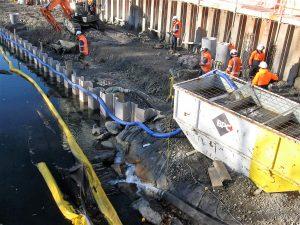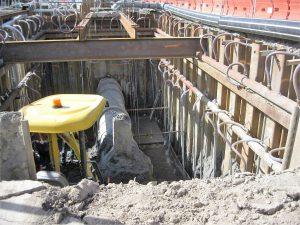Specific Tasks
Dewatering
What, and issues to look out for
What

Dewatering from a well point, and discharging into the river via a settlement tank. Note that the discharge into the settlement tank must be smooth in order to make the first chamber effective.
To “dewater” means to remove water from excavations, tunnelling, trenches, stream diversions and sediment control devices. This could be groundwater or surface water. Dewatering is usually done by pumping.
Issues to look out for
- Dewatering often creates fine sediment that can have significant adverse effects on receiving waterways and be difficult to remove, even with the tools in this toolbox.
- Closely monitor the start of each pumping session as this is usually when most sediment is picked up. When pumps draw water down to the bottom of the trench or pit, they often draw in very dirty residual water, which will breach water quality rules if discharged.
- Have alternatives in place, so that water that is too dirty to be discharged can be collected, treated and discharged later once acceptable water quality has been achieved. Good alternatives include spare settlement tanks, tankers to remove dirty water and discharging the water to land where it will not enter a waterway.
- Be especially careful when dewatering small trenches, eg domestic sewer pipes, as this often causes discharge to waterways that breaches water quality rules. There are good alternatives available which should be used.
- Having enough space for effective retention tools is often a major challenge for dewatering.
- Dewatering requires close supervision and, if not monitored, has the potential go wrong fast!
Design essentials
As a general guide, regional rules limit the sediment that can be discharged into spring-fed or Banks Peninsula streams or a lake or wetland, which is no more than 50 milligrams per litre. For other waterways, it is no more than 100 milligrams per litre.
There are also other rules that you need to comply with so, before you start, check the latest information from Environment Canterbury.
Get a suitably experienced and qualified professional to prepare a Dewatering Plan, for any project where this is needed. The plan needs to include at least: specific dewatering procedures and methodology; dosing rates and batch dosing methodology if flocculent treatment is required; monitoring; and contingency measures (including a record sheet)
Other general design principles for dewatering are:
- You can often discharge small volumes of water, eg from domestic sewer trenches, to land to let the water soak away, while protecting waterway quality. Or, you can block off sumps and vacuum-suction the dirty water away, for appropriate disposal.
- You can pump small volumes of sediment-laden water to a silt fence or decanting earth bund (DEB), but take care to not overwhelm these devices. You will probably need to block off the DEB outlet before pumping so that you can batch dose the bund, to meet discharge water quality goals.
- Pump larger volumes to a sediment retention pond (SRP). Depending on the volumes you pump, the outlet may need to be blocked during pumping and the SRP treated following pumping. If so, pump dirty water to the forebay and not into the pond itself.
- Best practice is to pump the dirty water to a channel above the sensor of the flow-activated flocculent dosing system. By doing this, dirty water is treated as soon as it reaches the forebay of the SRP or the DEB.
- If DEBs or SRPs aren’t available, use settlement tanks to significantly reduce the sediment in discharged dewatering water. Make sure that the tanks are configured to promote the highest possible rate of settlement. For example, the water must enter the first chamber of the tank smoothly because, if it falls into the tank, it will cause turbulence which counteracts settlement. Also, investigate whether flocculants will enhance the retention of sediment.
- Pay particular care to the start and end of pumping – this is when dirty water is most likely to be discharged. If sediment is likely to be discharged at these times, consider tankering the dirty water away for disposal, rather than discharging it into a waterway. Or, hold the dirty water for settlement offline. Once the water is clean it can be released.
- The technique which usually pulls in the least sediment is to draw groundwater down below the excavation with spear points. You will still need to put the water through settlement treatment before discharge.
- If you are dewatering a section of a waterway, get help from suitably qualified experts before starting. Make sure that you have safely removed all the fish, eels and freshwater kōura before pumping. Monitor pools as the water level diminishes, to check for fish becoming stranded.
- Get permission from the stormwater network manager before starting to discharge. You’ll need to be able to meet their requirements for duration, rate of discharge and quality. Also, if rain is forecast, you may need to stop discharging so that the network isn’t overwhelmed and to avoid flooding.
- Dewatering on sites that may be contaminated needs particular care. Get professional advice before you start. Check Our expectations.
- Check whether your site is on the Listed Land Use Register. If it is contaminated or potentially contaminated, you’ll need advice on how to dewater the site without risk of polluting waterways.
- If your site is on the Listed Land Use Register, or you are aware that it has been contaminated in the past, you will need advice from a suitably qualified and experienced person before you start pumping. You may need resource consent to authorise the discharge of dewatering water. Where this is required, you must have this before the pumping starts. Ensure that you have specific permission from the stormwater network owner (in many cases this will be your local council), if your discharge is into a local stormwater network.
- You may need to take groundwater samples to have them tested for contaminants before dewatering operations starts properly. Ongoing tests of water quality during pumping may be required too.
- If you discover contaminated material during excavation or other activities, where later dewatering is going to be needed, you must not discharge dewatering water until the contamination has been assessed by a suitably qualified person and the network owner (if applicable) and Environment Canterbury have been informed. You may need to stop works at that point until risks have been managed satisfactorily.
- If water accumulates in pools on a contaminated site following rain, you will need to have that water removed from the site and disposed of lawfully (for example, by suction tanker). Don’t dispose of the water by discharging it into waterways or a local stormwater network.
- Check for more information about contaminated land.
- Monitor water quality using the tools available so you know if you are meeting your water quality goals.
Construction, operation and maintenance
- Plan for dewatering well before it is needed. Most excavation works will require some degree of dewatering.
- Plan and organise works and construction to minimise dewatering volumes – eg, only trench as much as you can work and backfill each day.
- Recycle the water wherever possible (eg for dust suppression or earthworks conditioning).
- Pump from the top using a float or similar to keep the intake off the bottom of the excavation (the area to be dewatered). This will remove cleaner water while avoiding mobilising the sediments at the bottom.
- Pump small volumes of water through dewatering bags or pipe socks.
- Pump larger volumes of water to a turkey’s nest for treatment before it is discharged.
- The outlet to any pumped water must not create any erosion issues. You might need to construct an energy dissipater and stabilised area to discharge the pumped flows.
- You will need to monitor the pumped discharge to ensure that it meets required discharge standards at all times.
- Be especially careful with pumping, because it produces fine-textured sediments that are very difficult to retain on site.
- Sediment retention measures are far less effective for controlling dewatering than erosion control measures, which reduce dewatered volumes in the first place.
- Ensure that any devices that receive pumped flows are suitably sized and appropriately located. Remember that these devices can hold a significant weight of water when full.
- The outlet of any pump must be securely connected or fixed to any device receiving these flows.
-

Large settlement tanks for treating dewatering water. Note that water going into the tank needs to be smooth in order to effectively settle sediment. Do this by forcing the water against a plate (Source: Downer).
-

Large settlement tanks for treating dewatering water. Note that water going into the tank needs to be smooth in order to effectively settle sediment. Do this by forcing the water against a plate (Source: Downer).
-

Dewatering into a sediment bag and onto a large area of pasture.


